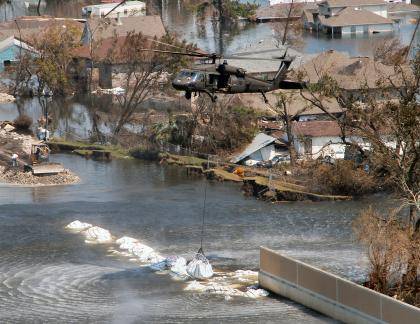In the Classroom, a Decade of Lessons from Hurricane Katrina
In the aftermath of Hurricane Katrina 10 years ago, engineering professor David Schaad built a new course that has changed and endured for a decade.

A decade ago and in the aftermath of Hurricane Katrina, Duke engineering professor David Schaad launched a new course he hoped might do some good in the wake of that horrendous natural disaster.
Schaad wasn’t sure the course, “Natural Catastrophes: Rebuilding from Ruins,” would gain much traction or have any sustainable interest.
It did. The first iteration enrolled nearly 180 students, 130 of which spent their Spring Break working in New Orleans.
The course continues today, though it has changed a bit to examine other natural disasters and ways to help rebuild communities. Here, Schaad, a civil and environmental engineering professor in the Pratt School of Engineering, discusses the experience with Duke Today.
DUKE TODAY: After Katrina, you put a class together examining how to rebuild after a natural disaster. You weren’t sure of the interest level, but a whopping 180 students enrolled. Why do you think Katrina resonated that much?
DAVID SCHAAD: Ten years ago the immensity of the devastation of Hurricane Katrina resonated in very palpable ways. The images on television made the realities of the human suffering so intense and to see the magnitude of the tragedy in such a major city was unprecedented. Many students experienced this in a personal way and wanted to do something to partner with the people of New Orleans. I was surprised by the interest level in the course, but after interacting with the students, and especially the Spring Break Trip to the Big Easy, it was apparent how invested each of them were in wanting to support the people who had experienced, and lost, so much.
DT: Is there still much for engineering students to learn now, a decade after the hurricane?
DS: The impacts of Hurricane Katrina are less obvious these days, but the aftermath of the storm teaches us a great deal about who suffers the most when a disaster strikes. In many cases it is marginalized people groups, usually without a large amount of financial resources who were evacuated, and are still living in Houston because they don't have the resources to rebuild. In many ways the City of New Orleans is more vibrant and alive than ever before, but that renewal has been different for different people.
DT: How can the Katrina experience help students more generally learn about other natural disasters, including those in other parts of the world?
DS: Unfortunately, Katrina has faded into the collective consciousness, even though many people are still dealing with the aftermath of relocating and starting over. However, the reality and frequency of natural disasters has only increased in the past decade. From tornadoes in Moore, Oklahoma; Super Storm Sandy in the Northeast; devastating earthquakes in both Haiti and Nepal; flooding in Pakistan; and droughts in California and Texas, it is clear that we as a society need to do a better job of planning for, and recovering from "disaster" events.
DT: What do or should today’s students — in your class and others like it — be learning in order to accomplish that? What areas in particular need to be addressed, emphasized and focused on?
DS: Students learn to think more holistically about the problems. Consider the wild fires currently burning in the western United States - what are the policy decisions, economic situation, and environmental setting which are causing these fires to threaten many homes? How do we teach students to view these issues through a multi-faceted lens? These are not intractable problems, just challenging - and we need to be equipping students to address these scenarios more completely.